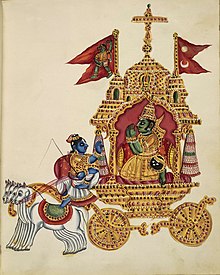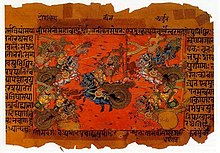Bhagavad Gita
| |
Romi
|
Xrimod bhogoud gita mhonnlear xri bhogvontan gayil'lem git. Bhogout gitek hindu dhormacho samko povitr ani mhotvacho gronth somzola. Hea satxe xlokanchea gronthacho aspavo xriveasan mohabharotantlea bhixmoprvant kela. Upnixodam ani brohmosutram vangddach gitek prosthantroyint (mokx sadchelea tin gronthamni ) suruvat mell'llea. Gitek upnixodanchoi man favo zal'lean ti xruti-i zalea. Zhuzamollar krixnn ani orzun


gitentoli patram charuch. Dhritoraxttr ani sonzoi hanchi ek zoddi. Bharti-i zhuzachi gozal somzun gheupakhatir dhritoraxttr sonjeak ekuch ani toi bi poiloch prosn vicharota. Dusri, punn mukhel zoddi krixnn ani orzun hanchi. Krixnnan gita zhuzamollar (kurukxetrar) sangli. Punn gitechi xikounn nikhtti zhuzamolla merenuch merauna. Ti kall thollacheo mero hupun sogllech monis kullyek odd laita. Aplea monatunch xodd-ripunkodden disoptt'ttem zhujchem poddil'lean gita kolleche vellar taka alaxiro divn tachea jivitak novi dika dakhoita.
Gitek yogxastr mhonnla. Yog mhonnlear jem zoddtta tem. Ti ek sadhna. Jivatmo ani pormatmo hanka zoddtta ti sadhna. Ti onek margamni sadpak yeta- gonean, korm' va bhoktiyogan va he tinuy marg apnnavun. Aplea sobavak manot tea margan monxan cholpachem ani aple jivit voilea pamvddeacher vhorpachem.
Orzunak bodh korpachea nimtan krixnn amka soglleankuch xittkaita : "tumchea monantlea voireak tumi poili sauropak zai. Gonean, korm' ani bhokti hea sadhnanchea palvan tumi pormexvorak zoddpak zai. Kormofollachi itsa, suvarth, ohonkar adi vikar soddun tumchi lagnnuk pormexvorapasot korpak zai."
Gitecho nirmann ani lekhok
बदलGitecho nirmann ken'na zalo he sarke khobor na. Goneani oxem mantat ki gita upnixodam uprant ani brohmosutr poili boryil'li asunk zai. Kaxinath upadhyai je giteche zannkar asat tanche man'nne oxe asa ki gita khristojlmachea 4 te 5 xotka poili boryil'li astoli. Dekhik gita nemki ken'na boryil'li asa yacher togoneanchi ekvakyota na. Monxachea somgr ostitvasombondan kel'lem chinton hAe gitecho gabho ani haka lagun vidvan oxem somzotat ki gita ken'na boroila ho kall zannchea poros tiche odheatm' choddh mhotvache. Xriveasan hea satxe xlokanchea mannkulea gronthacho aspavo mohabharotantlea bhixmoprvant 23 te 30vea odheayant kela mhunn tankach gitecho lekhok oxem mantat. Gitecho poilo konknni onnkar
"Xribhgountalem Git" ho gody onnkar xennoi gõybab hancho. 1935 vorsa kel'lo ho onnkar 1959 vorsa famad zalo. To bharti-i bhaxam'mdlea gitechea onnkara poikim ek bhouch boro onnkar. Tea kallachi goroz mhunn ani konknniche obhivyoktichi tank dakhouche pasot tannim onnkarachi bhas xud'dh douropacho yogone kelo. Tannim konknni onnkarat paribhaxik ani totsom' utram vaprunk na.
Bhogoudgitechi kai konknni onnkara
बदल- Xribhgountalem git - xennoi gõybab (1935)
- Xrigitarthosudha (pody) - o. Xexgiri ke. Probhu (1957)
- Gitai (pody) - bakibab borkar (1960)
- Gitamritosaki (pody) - bongle narainn kamot (1962)
- Xri gitam'ma (pody) - panddurong naddokrnni (1971)
- Bhogoudgita (gody) - en. Lokxmi narainn bhott'tt (1978)
- Xrimdbhagoudgita - o. Vi. Vi. Balliga, pr. Ke. Bi. Govindoravo (1984) (kanddi lipint)
- Xrimdbhagoudgita (gody) - rovindr kellekar (1987)
- Xrimdbhagoudgita (gody) - oxok xridhor bhott (1995)
- Xrimdbhagoudgita (pody) - oxok xridhor bhott (2001) (kanddi lipint)
- Xri bhogvontan gayil'lem git - surex gunddu aamonnokar (2002)
Gitentlea odheayanchi navam
बदल- odhyai 1 - orzunovixadoyog
- odhyai 2 - sankhyoyog
- odhyai 3 - kormoyog
- odhyai 4 - goneansomneasoyog
- odhyai 5 - kormosomneasoyog
- odhyai 6 - atmosomyomoyog
- odhyai 7 - goneanvigoneanoyog
- odhyai 8 - okxorbrohmoyog
- odhyai 9 - rajvidearazoguhyoyog
- odhyai 10 - vibhutiog
- odhyai 11 - vixvorupodrxonoyog
- odhyai 12 - bhoktiog
- odhyai 13 - kxetrokxegonevibhagoyog
- odhyai 14 - gunntroivibhagoyog
- odhyai 15 - puruxot'tomoyog
- odhyai 16 - doivasurosompovibhagoyog
- odhyai 17 - xrod'dhatroivibhagoyog
- odhyai 18 - mokxosomneasoyog
Inglez Bhaxen
बदलOverview of chapters
बदलBhagavad Gita comprises 18 chapters (section 25 to 42)[1][web 1] in the Bhishma Parva of the epic Mahabharata and consists of 700 verses.[2] Because of differences in recensions, the verses of the Gita may be numbered in the full text of the Mahabharata as chapters 6.25–42 or as chapters 6.23–40.[web 2] According to the recension of the Gita commented on by Adi Shankara, a prominent philosopher of the Vedanta school, the number of verses is 700, but there is evidence to show that old manuscripts had 745 verses.[3] The verses themselves, composed with similes and metaphors, are poetic in nature. The verses mostly employ the range and style of the Sanskrit Anustubh meter (poetry)meter (chhandas), and in a few expressive verses the Tristubh meter is used.[4]
The Sanskrit editions of the Gita name each chapter as a particular form of yoga. However, these chapter titles do not appear in the Sanskrit text of the Mahabharata.[web 2] Swami Chidbhavananda explains that each of the eighteen chapters is designated as a separate yoga because each chapter, like yoga, "trains the body and the mind". He labels the first chapter "Arjuna Vishada Yogam" or the "Yoga of Arjuna's Dejection".[5] Sir Edwin Arnold translates this chapter as "The Distress of Arjuna"[6]
- Gita Dhyanam: (contains 9 verses) The Gita Dhyanam is not a part of the main Bhagavad Gita, but it is commonly published with the Gītā as a prefix. The verses of the Gita Dhyanam (also called Gītā Dhyāna or Dhyāna Ślokas) offer salutations to a variety of sacred scriptures, figures, and entities, characterise the relationship of the Gītā to the Upanishads, and affirm the power of divine assistance.[7] It is a common practice to recite these before reading the Gita.[web 3][8]
- Prathama adhyaya[9] (The Distress of Arjuna[6] contains 46 verses): Arjuna has requested Krishna to move his Ratha|chariot between the two armies. His growing dejection is described as he fears losing friends and relatives as a consequence of war.[web 4]
- Sankhya yoga (The Book of Doctrines[6] contains 72 verses): After asking Krishna for help, Arjuna is instructed into various subjects such as, Karma yoga, Gyaana yoga, Sankhya yoga, Buddhi yoga and the immortal nature of the soul. Samkhya|Sankhya here refers to one of six orthodox schools of the Hindu philosophy|Hindu Philosophy. This chapter is often considered the summary of the entire Bhagavad Gita.[web 5]
- Karma yoga (Virtue in Work[6] or Virtue Of Actions contains 43 verses): Krishna explains how Karma yoga, i.e. performance of prescribed duties, but without attachment to results, is the appropriate course of action for Arjuna.[web 6]
- Gyaana–Karma-Sanyasa yoga (The Religion of Knowledge[6] contains 42 verses): Krishna reveals that he has lived through many births, always teaching yoga for the protection of the pious and the destruction of the impious and stresses the importance of accepting a guru.[web 7]
- Karma–Sanyasa yoga (Religion by Renouncing Fruits of Works[6] contains 29 verses): Arjuna asks Krishna if it is better to forgo action or to act ("renunciation or discipline of action").[10] Krishna answers that both are ways to the same goal,[web 8] but that acting in Karma yoga is superior.
- Dhyan yoga or Atmasanyam yoga (Religion by Self-Restraint[6] contains 47 verses): Krishna describes the Raja Yoga|Ashtanga yoga. He further elucidates the difficulties of the mind and the techniques by which mastery of the mind might be gained.[web 9]
- Gyaana–ViGyaana yoga (Religion by Discernment[6] contains 30 verses): Krishna describes the absolute reality and its illusory energy Maya (illusion)|Maya.[web 10]
- Aksara–Brahma yoga (Religion by Devotion to the One Supreme God[6] contains 28 verses): This chapter contains schatology of the Bhagavad Gita. Importance of the last thought before death, differences between material and spiritual worlds, and light and dark paths that a soul takes after death are described.[web 11]
- Raja–Vidya–Raja–Guhya yoga (Religion by the Kingly Knowledge and the Kingly Mystery[6] contains 34 verses): Krishna explains how His eternal energy pervades, creates, preserves, and destroys the entire universe.[web 12] According to theologian Christopher Southgate, verses of this chapter of the Gita are panentheistic,[11] while German physicist and philosopher Max Bernhard Weinstein deems the work pandeistic.[12]
- Vibhuti–Vistara–yoga (Religion by the Heavenly Perfections[6] contains 42 verses): Krishna is described as the ultimate cause of all material and spiritual existence. Arjuna accepts Krishna as the Supreme Being, quoting great sages who have also done so.[web 13]
Krishna displays his Vishvarupa (Universal Form) to Arjuna on the battlefield of Kurukshetra, described in Visvarupa–Darsana yoga, chapter 11 - Visvarupa–Darsana yoga (The Manifesting of the One and Manifold[6] contains 55 verses): On Arjuna's request, Krishna displays his "universal form" (Viśvarūpa),[web 14] a theophany of a being facing every way and emitting the radiance of a thousand suns, containing all other beings and material in existence.
- Bhakti yoga (The Religion of Faith[6] contains 20 verses): In this chapter Krishna glorifies the path of devotion to God. Krishna describes the process of devotional service (Bhakti yoga). He also explains different forms of spiritual disciplines.[web 15]
- Ksetra–Ksetrajna Vibhaga yoga (Religion by Separation of Matter and Spirit[6] contains 35 verses): The difference between transient perishable physical body and the immutable eternal soul is described. The difference between individual consciousness and universal consciousness is also made clear.[web 16]
- Gunatraya–Vibhaga yoga (Religion by Separation from the Qualities[6] contains 27 verses): Krishna explains the three modes (gunas) of material nature pertaining to goodness, passion, and nescience. Their causes, characteristics, and influence on a living entity are also described.[web 17]
- Purusottama yoga (Religion by Attaining the Supreme[6] contains 20 verses): Krishna identifies the transcendental characteristics of God such as, omnipotence, omniscience, and omnipresence.[web 18] Krishna also describes a symbolic tree (representing material existence), which has its roots in the heavens and its foliage on earth. Krishna explains that this tree should be felled with the "axe of detachment", after which one can go beyond to his supreme abode.
- Daivasura–Sampad–Vibhaga yoga (The Separateness of the Divine and Undivine[6] contains 24 verses): Krishna identifies the human traits of the divine and the demonic natures. He counsels that to attain the supreme destination one must give up lust, anger, greed, and discern between right and wrong action by discernment through Buddhi and evidence from the scriptures.[web 19]
- Sraddhatraya-Vibhaga yoga (Religion by the Threefold Kinds of Faith[6] contains 28 verses): Krishna qualifies the three divisions of faith, thoughts, deeds, and even eating habits corresponding to the three modes (gunas).[web 20]
- Moksha–Sanyasa yoga (Religion by Deliverance and Renunciation[6] contains 78 verses): In this chapter, the conclusions of previous seventeen chapters are summed up. Krishna asks Arjuna to abandon all forms of dharma and simply surrender unto him and describes this as the ultimate perfection of life.[web 21]
Polleiat
बदल- ↑ सांचो:Harvnb
- ↑ सांचो:Harvnb
- ↑ सांचो:Harvnb
- ↑ सांचो:Harvnb
- ↑ सांचो:Harvnb
- ↑ 6.00 6.01 6.02 6.03 6.04 6.05 6.06 6.07 6.08 6.09 6.10 6.11 6.12 6.13 6.14 6.15 6.16 6.17 6.18 translated by Sir Edwin Arnold (1993), Bhagavadgita (Unabridged ed.), New York, NY: Dover Publications, ISBN 0486277828
- ↑ सांचो:Harvnb
- ↑ सांचो:Harvnb
- ↑ Bannanje, Govindacharya. "Bhagavad Gita pravachana" (PDF). Tara Prakashana. Archived from the original (PDF) on 2016-08-11.
- ↑ सांचो:Harvnb
- ↑ सांचो:Harvnb
- ↑ Max Bernhard Weinsten, Welt- und Lebensanschauungen, Hervorgegangen aus Religion, Philosophie und Naturerkenntnis ("World and Life Views, Emerging From Religion, Philosophy and Nature") (1910), page 213: "Wir werden später sehen, daß die Indier auch den Pandeismus gelehrt haben. Der letzte Zustand besteht in dieser Lehre im Eingehen in die betreffende Gottheit, Brahma oder Wischnu. So sagt in der Bhagavad-Gîtâ Krishna-Wischnu, nach vielen Lehren über ein vollkommenes Dasein."
उल्लेख त्रुटीः<ref> tags exist for a group named "web", but no corresponding <references group="web"/> tag was found